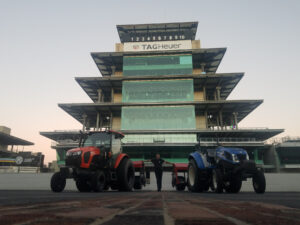For more expert drag racing track prep tech tips, tricks, and advice, please contact Total Venue Concepts.
Even the car with the best setup, the most power, and the greatest tuner will be practically worthless without a proper racing surface and a well-prepped track. It doesn’t matter how much money is spent trying to break records, or how successful the team is—traction is everything, and having the right surface can make or break a track.
Kurt Johnson, owner of Total Venue Concepts (TVC), has dedicated his career to honing his skills as a track prep and traction specialist. Johnson is an expert on the intricacies of concrete, traction compounds, equipment, facility design, and everything in between, and he has plenty of solid advice to offer to fellow track prep junkies as well as track owners and operators.
Prior to starting TVC in 2015, the former United States Marine worked as the Track Manager at Summit Motorsports Park in Norwalk, Ohio, and as the Director of Operations for Lucas Oil Raceway in Indianapolis, Indiana. He’s also worked with the NHRA as well as Don Schumacher Racing and many others.
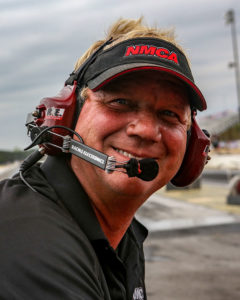 Now, Johnson roams the globe helping tracks and sanctioning bodies to improve their programs; Total Venue Concepts is the official track prep service provider of the National Muscle Car Association (NMCA), National Mustang Racers Association (NMRA), and the Outlaw Diesel Super Series (ODSS), and has provided services for NASCAR, INDYCAR, and Formula 1.
Now, Johnson roams the globe helping tracks and sanctioning bodies to improve their programs; Total Venue Concepts is the official track prep service provider of the National Muscle Car Association (NMCA), National Mustang Racers Association (NMRA), and the Outlaw Diesel Super Series (ODSS), and has provided services for NASCAR, INDYCAR, and Formula 1.
Recently, Dragzine’s Ainsley Jacobs sat down with Johnson to discuss TVC’s top traction tech tips for tracks to help improve their racing surfaces.
Dragzine: What’s the most common mistake you see with track prep or surface maintenance?
Kurt Johnson: Not scraping the old rubber off the racetrack. As you run cars, the tires leave rubber on the track. That isn’t always a bad thing, but there’s also a ton of stuff that comes out of the car—leaks, exhaust, everything—and things you don’t even see that get left behind. For example: the condensation coming out of the headers has petroleum in it and that gets trapped in the rubber. So, scraping is more than just taking the rubber off the track, as you’re actually cleaning the track at the same time.
Ideally, scraping to the 60-foot mark should be done on a weekly basis as part of routine maintenance. Smaller tracks might have a harder time since it takes personnel (money) and time, but it’s like working on your car… it needs to happen. If you’re racing Friday, Saturday, and Sunday, get the track scraped on Thursday and take all the junk off!
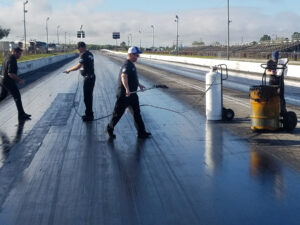 If you can, scrape another 100-feet past the 60-foot mark. Each week, start the next 100-foot-long section from where you left off the week before. On an 1/8-mile track, doing this will let you rotate and refresh the entire surface every six weeks all the way down—and it only takes about 1.5 hours per week to do it.
If you can, scrape another 100-feet past the 60-foot mark. Each week, start the next 100-foot-long section from where you left off the week before. On an 1/8-mile track, doing this will let you rotate and refresh the entire surface every six weeks all the way down—and it only takes about 1.5 hours per week to do it.
After you scrape, you have the ash left over from burning everything off, so the next important step is to wash the surface. Wash the entire racing surface. A lot of tracks don’t have a scrubber, but you don’t really need one… a broom on the front of a tractor isn’t as effective but it’s definitely better than nothing.
Scrape it, wash it, drag it, spray it, repeat—and you’ll always have a good racetrack.
Dragzine: When is it necessary to service a track?
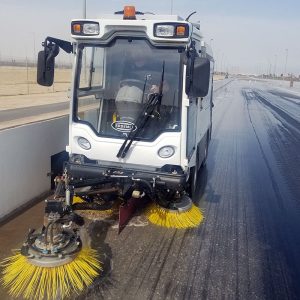 KJ: When you start to see excessive concrete degradation. The American Concrete Institute (ACI) says most concrete has a 10–15-year shelf life, but we do things in racing that concrete isn’t made for, and most tracks go beyond its shelf life anyway. Cracks aren’t necessarily bad on a track, but when you start to see the edges of a crack degrade, it’s time to service it. Racing is only going to accelerate the damage further.
KJ: When you start to see excessive concrete degradation. The American Concrete Institute (ACI) says most concrete has a 10–15-year shelf life, but we do things in racing that concrete isn’t made for, and most tracks go beyond its shelf life anyway. Cracks aren’t necessarily bad on a track, but when you start to see the edges of a crack degrade, it’s time to service it. Racing is only going to accelerate the damage further.
When aggregates start coming out of the surface, the cementitious material falls away, or cracks start to crumble, it’s time to think about service… and that’s just the concrete surface. There’s also the subgrade dirt below to worry about! Heaving situations where water is under the track, ground swelling in places that causes humps and bumps, or flowing that can create tunnels and cause caving or dips are also major concerns that can destroy what would otherwise be good concrete and cause failures.
Dragzine: What other types of surface maintenance need to be addressed regularly?
KJ: Texture is a big thing. Rotators and big-tire cars like Pro Mods or Fuel cars, basically anything with a lot of wheel speed, actually smooths out the surface and takes the texture that holds the rubber away.
West Coast concrete is harder than the softer East Coast concrete, so you need to make sure that texture gets replaced as a part of a regular maintenance program. On the East Coast, for example, we go in about once a year and put the swirl marks back that can get ground down. We also have a chemical that we can use to harden the surface after we grind, and we’ve seen really good results when it’s used properly.
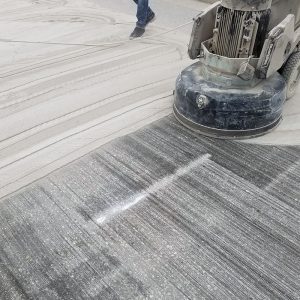 Additionally, any place where concrete meets asphalt has to be maintained every year. The different materials expand at different rates, so the gap that keeps it level and butted together goes away. If you don’t service it, a bump or dip will form.
Additionally, any place where concrete meets asphalt has to be maintained every year. The different materials expand at different rates, so the gap that keeps it level and butted together goes away. If you don’t service it, a bump or dip will form.
Dragzine: Do you have any tips to improve surface longevity and concrete shelf life?
KJ: After concrete has been poured, relief cuts are made to give it a place to crack—because it is going to. When water freezes, it expands and has a huge amount of power that will crack your concrete and degrade your tracks. On Northern tracks where the temperatures change a lot throughout the year, you need to fill your joints, but you need to make sure you’re doing it properly. On Southern tracks, rainwater will enter your subgrade from the cracks that are designed to form in the reliefs.
Most companies that do crack filling are used to the highway world where they fill them flush as required by the Department of Transportation, but that doesn’t work in racing. If you fill the joints to the surface, as they push together the filler gets pushed up and drags, rotators, and racecars all take it down the track and mix it into the traction compound.
The correct way to fill a joint on a track is to fill it to 1/2-inch or 1/4-inch below the surface.
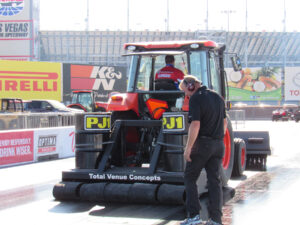 For all tracks, though, we recommend leaving the rubber on during the winter. A lot of places like to scrape before winter—don’t! The rubber acts as a sunscreen and a winter protectant that will keep the weather off the surface. The most successful tracks do an entire track scrape at the beginning of the year right before the season gets started.
For all tracks, though, we recommend leaving the rubber on during the winter. A lot of places like to scrape before winter—don’t! The rubber acts as a sunscreen and a winter protectant that will keep the weather off the surface. The most successful tracks do an entire track scrape at the beginning of the year right before the season gets started.
Dragzine: What are your thoughts on track prep, traction compounds, and glue in general?
KJ: Advancements in traction compound in recent years have allowed us to crush records left and right, which is awesome, but it can tear up tracks, especially older ones. We can absolutely go faster than we are now, but we would have to add so much glue that the concrete just couldn’t handle it, so we back off by not putting down that much, otherwise we would take tracks beyond what they can structurally do.
We also have worked with circle track and road racing tracks, including NASCAR, and the progress we’ve been able to make with speeds and records through proper track prep is astounding.
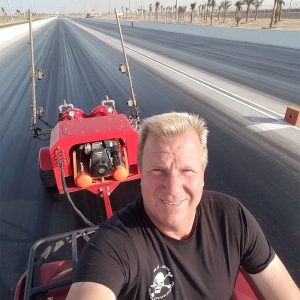 At World Wide Technology Raceway in Madison, Illinois, we helped repave their oval after the last race in 2017. After installing our new surface, with VP traction compound and lots of tire dragging, we increased the overall number of passes at their NASCAR race from 484 in 2017 to 667 in 2018 and 866 in 2019 while green flag passes for the lead went from 5 in 2017 to 8 in 2018 and 16 in 2019.
At World Wide Technology Raceway in Madison, Illinois, we helped repave their oval after the last race in 2017. After installing our new surface, with VP traction compound and lots of tire dragging, we increased the overall number of passes at their NASCAR race from 484 in 2017 to 667 in 2018 and 866 in 2019 while green flag passes for the lead went from 5 in 2017 to 8 in 2018 and 16 in 2019.
Dragzine: How do you prep for No Prep?
KJ: If you truly want a No Prep surface, you have to scrape the whole dang track to where they’re off the gas and off the power. Then, you need to wash the absolute crap out of it. Traction compound gets embedded in air pockets and comes back out as runs are made and mixes with the rubber that gets put down, so you have to wash well beyond what you think you think you need.
Racing rubber is naturally sticky, and every time a car goes down, they’re turning the tires so hard that it’s like a rotator on each run—it makes a beautiful track. I’ve been to No Prep tracks where, after the first round, they’re better than most other tracks. No Prep actually gives you one of the best surfaces possible, because it’s consistent rubber to rubber (as long as they’re water only races and not putting chemicals down in the burnouts) and puts an incredible base on! I highly recommend running a No Prep race before a big, sticky tire-prepped race.
Dragzine: When should a track outsource its prep and equipment versus doing it in-house?
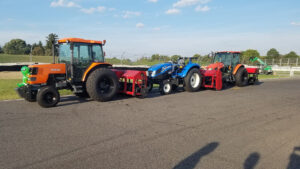 KJ: Prepping a racetrack really isn’t difficult and almost every track is successful at it. Outsourcing really comes down to can a track afford or justify the capital expenditure needed to purchase the proper equipment, or employ the manpower to run a large-scale event. Sometimes finances can be prohibitive, and that’s where hiring a track prep company or service with an experienced team can be a huge benefit.
KJ: Prepping a racetrack really isn’t difficult and almost every track is successful at it. Outsourcing really comes down to can a track afford or justify the capital expenditure needed to purchase the proper equipment, or employ the manpower to run a large-scale event. Sometimes finances can be prohibitive, and that’s where hiring a track prep company or service with an experienced team can be a huge benefit.
When I pull in to work at an event, I have anywhere from $150,000-$300,000 in equipment and tools with me. All of my equipment is current and well-maintained; we can minimize potential downtime due to breakage because I have three or four of everything. Plus, it looks good for the facility that we have new, premium everything.
It’s also a really great decision for sanctioning bodies to outsource their track prep to contractors because of the consistency it aprovides. Regardless of where a race is held, the surface will be similar, which the racers love and expect. We work for NMRA, NMCA, and ODSS while Tyler Crossnoe [Track Manager at Virginia Motorsports Park] does all of the PDRA races.
Dragzine: What can track managers do right now during the “Coronavirus offseason” to use it as an advantageous opportunity to better prepare for when racing resumes?
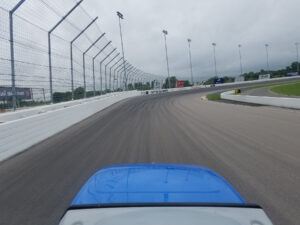 KJ: Do a full scrape. A lot of tracks that usually don’t have the time and the manpower to do it, right now you can easily find both. Plus, you can keep your social distance while scraping and you’ll already be wearing personal protective equipment!
KJ: Do a full scrape. A lot of tracks that usually don’t have the time and the manpower to do it, right now you can easily find both. Plus, you can keep your social distance while scraping and you’ll already be wearing personal protective equipment!
It’s also a great time to grind your track because that does take time and typically gets put off until the winter… but, in the winter you’re dodging the weather, and right now the weather is great and time is abundant. You can get your track textured, ground, and cleaned all by the time we start racing again.
For more information about track prep, traction, or other surface-related subjects, contact Johnson at TotalVenueConcepts.com.

